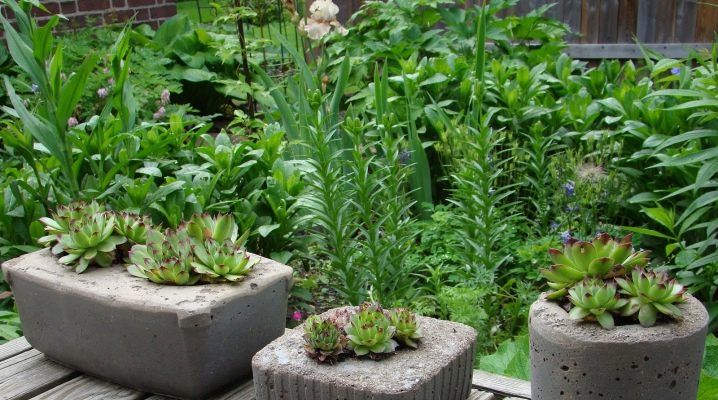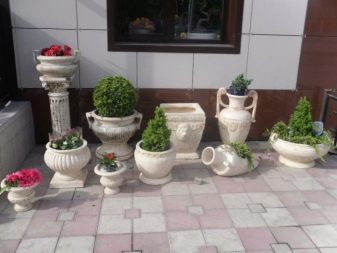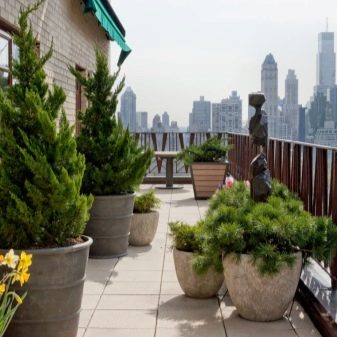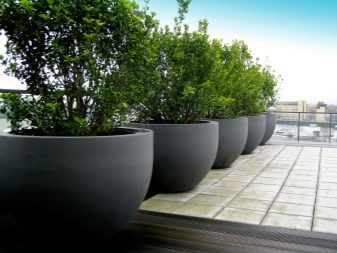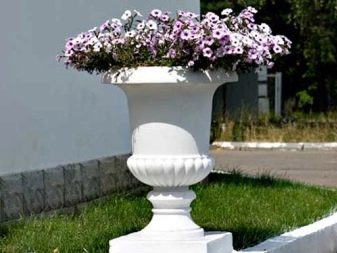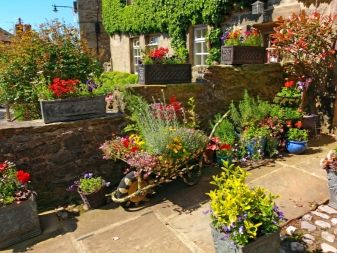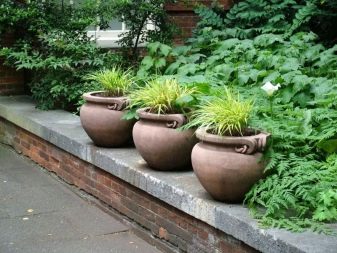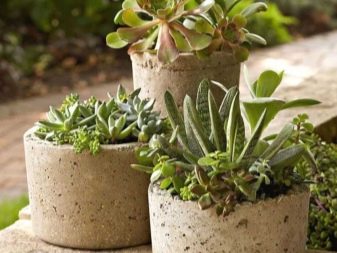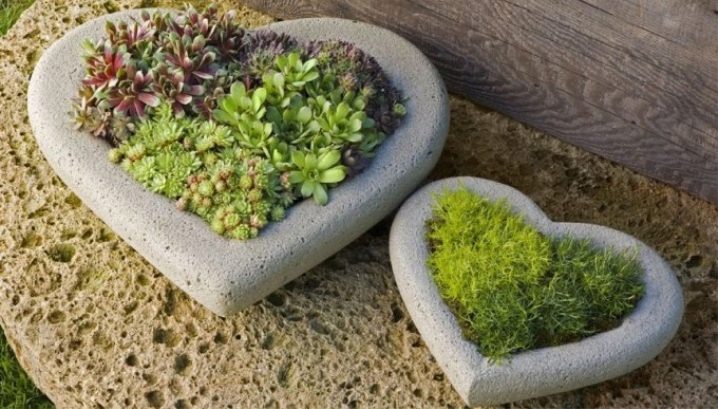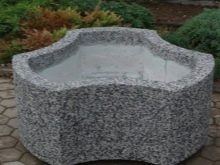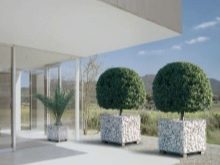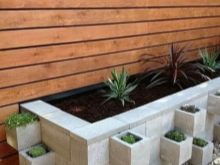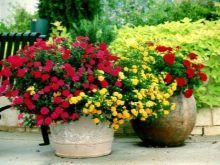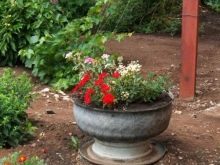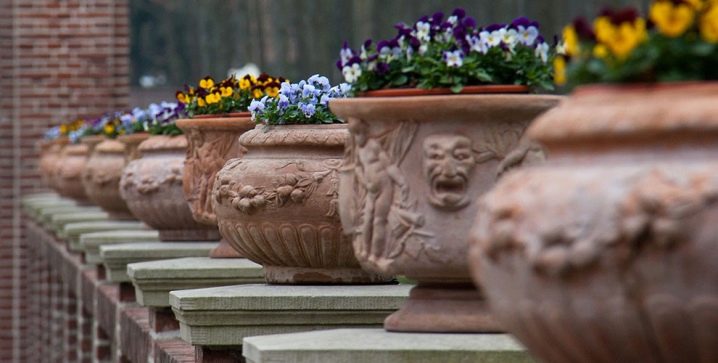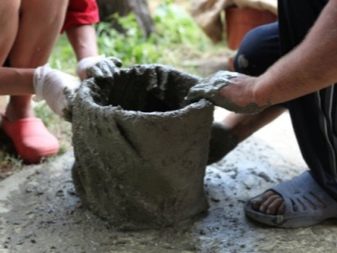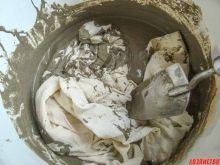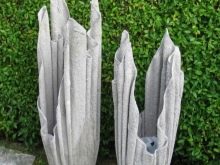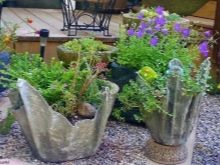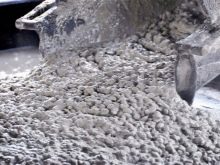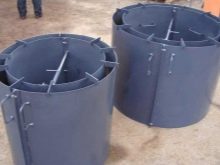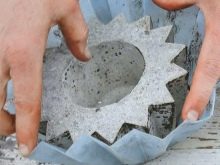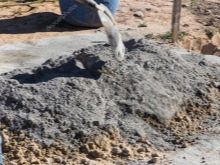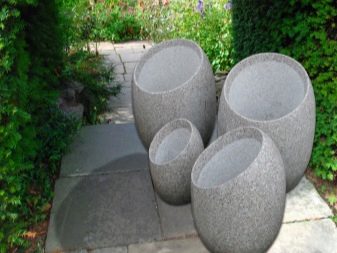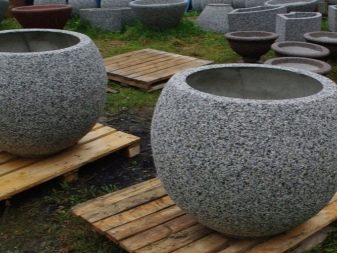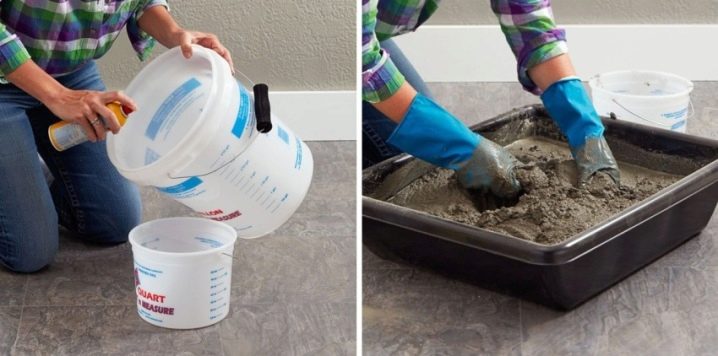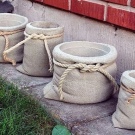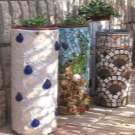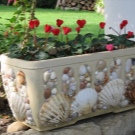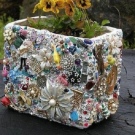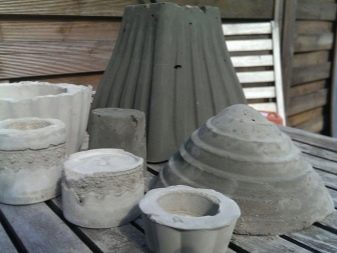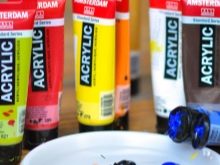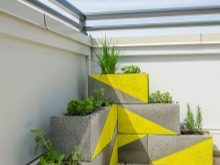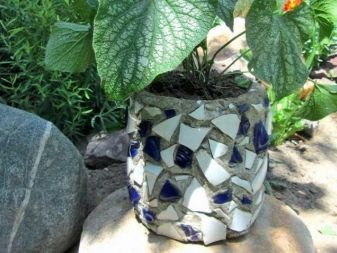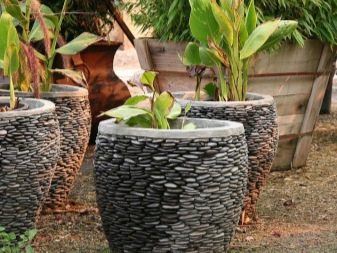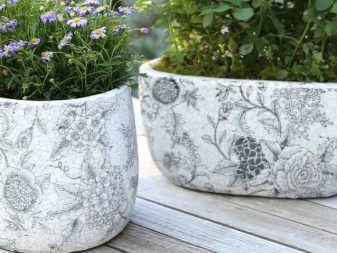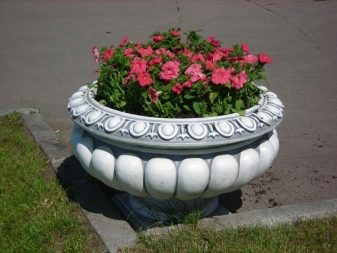Making your own pot of concrete: the perfect setting for outdoor colors
History relates the use of concrete flower flowerpots to the traditions of park art in palaces. The royal summer residences were unthinkable without luxurious alleys, and the avenues without the prudish baroque concrete bowls. Gradually, the flowerpots turned into modernity, received a permanent residence permit in the city gardens, near the main entrances of the buildings. Designers loved them for the opportunity to set off the greens in a practical small architectural form. Consider options for how to make such a capacity with his own hands.
Current trends in landscape design
Landscape designers agree that flowerpots made of concrete give particular presentability to the owners of the garden, cottage or cottage.Flower bowls at the same time decorate the territory, and perform the practical function of a platform for placing green plants almost anywhere. Trends decorating house territories require from the owners of the flowerpots that the containers were made of materials that resemble the natural as much as possible.
Making lawns of natural stone - is too complicated and expensive. A practical direction in their creation is the use of materials for the monolithic composition: concrete and cement.
Concrete flowerpots design artists find particularly functional.
With the help of such massive bowls:
- a special aura of a country or city house adjoining plot is born;
- Concrete pots zone space, collect its details into a single picture.
Massive vases are actively used by decorators in private households, parks, squares, at sites at the entrance to cultural objects, as well as to administrative buildings.
Concrete vases have a lot of advantages that determine their popularity:
- Bowls are affordable, it does not hit the budget;
- concrete is not afraid of moisture, fire, frost, it is strong enough;
- availability of capacity for the implementation of any ideas of artists (vases can be given a very different form);
- environmental friendliness and mobility: plants grow excellently in such pot; for capricious colors, you can choose an exclusive place to install the bowl;
- street vases can be made in the style preferred by the customer (from modern to classic);
- Concrete is amenable to painting and finishing, so it is easy to decorate flowerpots in any range.
Forms and sizes
The shape and size of the flowerpot is not limited by anything except the tastes of the owners of the territory that will be decorated with objects. The products made on industrial conveyors comply with the standard: they have a reinforced concrete frame, a bowl, a base, and sometimes a leg. Their height reaches 60 cm. You can get a copy of a more original form with your own hands.
For natural colors, concrete vases are given a solid depth. The view is set to any: cement mortar will take the parameters that you define it. Even if you like a hex, this configuration is also feasible, you only need to first construct its frame from wood, plywood or cardboard.
Practical rectangular vases, square,look great round large bowls. Unusual products involve the use of bowls, basins, even a bowling ball as shapes. This is the framework of the so-called inner form. In general, there are two forms: we need internal and external, between which the solution is poured. After the concrete has set, the internal frame is pulled out or broken.
When you decide on the size of the pot, be sure to relate it to the area of the site where you plan to expose the product. Do not squeeze a giant vase on a tiny patch: all the aesthetics will immediately be broken. Also, a small capacity will be lost in the vast garden. It is very uncomfortable to feel the flowers in a single vase on a long avenue.
It is necessary to achieve the proportions of concrete tanks with the surrounding interior.
How to: step-by-step master class
The steps will depend on how much pot you decide to create. Consider a specific example.
For a large product, you need a plastic mold with parameters about 53 cm in diameter and 23 cm in height. The solution is made of white cement, perlite (agro-perlite) and peat in a ratio of 2: 1: 2. The measuring container can be a 1.5-liter bucket.The mixture is diluted with water to obtain a thick mass.
This is a heavy lawn, it is better to do it right away at the place where it will stand constantly. Keep ready plastic form (internal). Put on the bottom of the solution with a thickness of 4-5 cm (easy to measure with a toothpick). We set the wire frame for strength. Due to the size of the tank, four to five batches of cement will be required.
Plastic pot, wrapped with plastic wrap, insert into the first form, straighten the folds. Lay the solution around the pot. It is necessary that such a bulky construction is completely dry (it will take at least 8 days). Then the pot is removed from the mold and treated with a brush. Washed and dried again. Cover with a wet sackcloth, a piece of cloth and leave to harden further until the material acquires a light shade: this is a sign that the bowl is ready.
A small concrete florist for the garden can be made by hand using cement mortar and ordinary rags.
The sequence of actions is as follows:
- As a takni, old towels or any thick fabric will work well. Under the initial form, use the old bucket (wear gloves on your hands).
- Turn the cement into a creamy consistency. Turn the bucket to dry the pot and close with polyethylene, otherwise you will not remove your product.
- Dip a towel or cloth in a container with a solution so that it is completely soaked. Then reach out and straighten.
- Put a towel in the cement on the upturned bucket, smooth the bottom. What is now the bottom of the bucket, then become the bottom of the vase. Folds let them hang down, you can give them any shape you want.
- Fabric with cement dries in this form for two days. Take out the bucket from under the frozen pot: here is the simplest flower girl.
What is needed?
It is necessary to list in detail the entire range of necessary materials to create a universal flowerpot.
- Concrete. It is easier to buy in the store ready mix.
- Forms and molds. Unleash the imagination, do not dwell on standards. The main requirement for the form is that you can get a dried product out of it. Almost any container will be suitable: cups, cardboard packs, glass containers that it is not a shame to break, jugs, basins.
- Non-stick spray. Concrete tanks are easy to remove, if before pouring process spray form; You can do with vegetable or motor oil.
- Water (for mixing the solution). Not cold and not hot, warm, in large quantities.
- A stick as thick as a pencil (necessary for cleaning air bubbles).
- Mixer for concrete (you can take a garden spatula).
- A rag for making the simplest flower girl made of cloth (certainly thick).
- Buckets and other containers, which then do not mind throwing away.
- Paints and broken ceramics (if you have to design the finished pot).
Preliminary work
In order to fully start working on a flower pot, it is better to make a detailed drawing of the product in advance. Then on it cut out the figure defined by the original template, or invented by you personally. The workpiece must be glued, for durability to pass glue over the entire surface.
It is logical to pre-prepare the composition of the desired consistency (the solution should not spread). To do this, take 2 parts of cement, 3 parts of sand, add water in small quantities, then the components are stirred until the solution is completely ready. When the mixture is mixed, you can start pouring it into the mold.
If suddenly you decide to wipe the luxurious version of a garden bowl of washed concrete, consider the characteristics of the material. Washed concrete contains natural stone (pebbles, crushed granite, quartzite, marble chips, travertine) and artificial additives (glass chips, smalt, cast iron).
The texture is unusually beautiful and durable. But this is achieved by complex manipulations. Concrete mix with the listed additives put in a form. The seized (semi-hardened) product is removed and the upper layer is washed out under pressure. Cement sand leaves, natural stone appears.
This is very impressive, but it is better to implement this topic together with professionals. The color of the product is unique, only natural stone has it.
Manufacturing process
For the manufacture of a classic concrete pot for the garden, you will have to take the necessary steps:
- Prepare a solution, the filler is created from small fractions. Maintain a ratio of parts of cement and sand 2 to 3. You can immediately add the pigment for the shade of the mixture. The solution should be of medium density.
- Forms that you intend to use for pouring, you must lubricate with vegetable oil to avoid adhesion of the solution.
- If the pot is designed with the bottom, for future colors, it is better to provide drainage immediately. It is performed as follows: a portion of the solution up to 2 cm is put into a large (first) form, tubes of metal are inserted vertically into this layer: after hardening, they will provide drainage holes.
- Next install the second (internal) capacity.It will be hard work to align the edges of the first and second forms. It is necessary to achieve the same size of the wall of the future lawn around the perimeter.
- The next step - carefully pour the solution, compacted in portions. No voids should remain, then the wall of the pot will be strong.
- If the second form turned out to be easy, pour small stones and sand into it. Knock on the walls with a hammer. We will pierce the mortar with a thin stick: it is necessary to free the concrete from air bubbles. He will then ask for a little. Then with a smooth object (spoon, garden spatula) we align the side and leave the “flowerpot” for a day.
- After 24 hours, take out the inner form, spray the pot inside with water and cover with plastic wrap. We must give it a final grab. Spray and cover several more times: drying and hardening should go evenly. Do not rush to avoid cracks.
- For absolute strength, the concrete is covered with a wet sacking or immersed in a bath of water, kept in such conditions for up to a week. It should dry slowly. And no direct rays of the sun, no acceleration of the solidification process should be allowed.
- Now it is necessary to take up the design (decoration) of the bowl. It can be painted with acrylic paint or laid out with pebbles, mirror fragments, and also shells. The product will become more beautiful if you carefully polish the entire surface with a special block. When the described technology is mastered, it is worth stocking up with enthusiasm and time. According to its authoring it will be easy to create a series of unique, fantasy containers for a yard or a country site.
Spectacular examples
In the collection of designer finds there are many different beautiful ideas and spectacular examples. Thin natures will not remain indifferent to the pot in the form of open palms. The technique is as follows: latex gloves are filled with a solution; they are given the shape of hands, carefully holding delicate flowers, before solidification.
Hungarian technology has gained its fans. Its essence is that the role of forms is performed by plywood templates with a semicircular notch and loops at the side of the wire.
The sequence of steps is as follows:
- In the center of a sheet of plywood (or roofing felt), we fall asleep a mixture of sand and cement, mix everything, form a hill; in it we create a well, where we carefully add water.
- We immerse a metal rod with loops from the template described at the beginning (we will create internal walls). We rotate the rod like potters: a hemisphere comes out of a mixture. Top put the film, again a layer of the mixture, then the metal grid, it is still a solution.
- The final stage is the use of the second template. He "backs" the outer walls of the product. And the result will be some kind of lace-fantasy design, completely unlike heavy cement monuments. It remains to remove the rod and leave the product to dry.
If the appearance of the pot seems faded, designers advise to decorate it. Effectively looks bright painting with acrylics. Concrete is easy to paint. You just need to carefully primed the surface before applying the painting, but do not overdo it in the palette. Decorations on the flowerpot should not dominate over the natural colors that you are going to grow in this capacity.
The unexpected effect of the iridescent multi-colored surface of the pot gives a mosaic finish. As a mosaic, you can use pieces of broken ceramic tiles.Tile fragments are placed after the surface of the concrete product is covered with a thick layer of special glue (5-6 cm layer). Tile is pressed into it.
The same method is suitable for decorating a flower container with pebbles. Only here you need to be alert, immediately remove traces of glue from the pebbles, otherwise you will not remove it later. To make it more elegant, the gaps between the fragments of the decor are rubbed off after the glue dries. Vases with mosaic, painted in Byzantine or Indian style look beautiful.
Concrete pots can also be made by a non-professional. The main thing is to learn step-by-step instructions and follow its recommendations. Concrete bowls look beautiful after decorating with paintings or stones. Thanks to your imagination, you get an exclusive and durable capacity in which you can grow flowers annually.
How to make a pot of concrete with their own hands, see below.
